These highlights do not include all the information needed to use TEMOZOLOMIDE CAPSULES safely and effectively. See full prescribing information for TEMOZOLOMIDE CAPSULES. TEMOZOLOMIDE capsules, USP, for oral use Initial U.S. Approval: 1999
Temozolomide by
Drug Labeling and Warnings
Temozolomide by is a Prescription medication manufactured, distributed, or labeled by NextSource Biotechnology LLC, Eirgen Pharma Ltd.. Drug facts, warnings, and ingredients follow.
Drug Details [pdf]
TEMOZOLOMIDE- temozolomide capsule
NextSource Biotechnology LLC
----------
HIGHLIGHTS OF PRESCRIBING INFORMATIONThese highlights do not include all the information needed to use TEMOZOLOMIDE CAPSULES safely and effectively.
See full prescribing information for TEMOZOLOMIDE CAPSULES. TEMOZOLOMIDE capsules, USP, for oral use Initial U.S. Approval: 1999 RECENT MAJOR CHANGESINDICATIONS AND USAGETemozolomide is an alkylating drug indicated for the treatment of adults with: DOSAGE AND ADMINISTRATION
DOSAGE FORMS AND STRENGTHS
CONTRAINDICATIONS
WARNINGS AND PRECAUTIONS
ADVERSE REACTIONS
To report SUSPECTED ADVERSE REACTIONS, contact NextSource Pharma at 1-855-672-2468 or FDA at 1-800-FDA-1088 or www.fda.gov/medwatch. USE IN SPECIFIC POPULATIONS
See 17 for FDA-approved patient labeling. Revised: 4/2025 |
FULL PRESCRIBING INFORMATION
1 INDICATIONS AND USAGE
2 DOSAGE AND ADMINISTRATION
2.1 Monitoring to Inform Dosage and Administration
Prior to dosing, withhold Temozolomide until patients have an absolute neutrophil count (ANC) of 1.5 x 10 9/L or greater and a platelet count of 100 x 10 9/L or greater.
For concomitant radiotherapy, obtain a complete blood count prior to initiation of treatment and weekly during treatment.
For the 28-day treatment cycles, obtain a complete blood count prior to treatment on Day 1 and on Day 22 of each cycle. Perform complete blood counts weekly until recovery if the ANC falls below 1.5 x 10 9/L and the platelet count falls below 100 x 10 9/L.
For concomitant use with focal radiotherapy, obtain a complete blood count weekly and as clinically indicated.
2.2 Recommended Dosage and Dosage Modifications for Newly Diagnosed Glioblastoma
Administer Temozolomide once daily for 42 to 49 consecutive days during the concomitant use phase with focal radiotherapy and then once daily on Days 1 to 5 of each 28-day cycle for 6 cycles during the maintenance use phase.
Provide Pneumocystispneumonia (PCP) prophylaxis during the concomitant use phase and continue in patients who develop lymphopenia until resolution to Grade 1 or less [see Warnings and Precautions ( 5.3)] .
Concomitant Use Phase:
The recommended dosage of Temozolomide is 75 mg/ m 2once daily for 42 days to 49 days in combination with focal radiotherapy. Focal radiotherapy includes the tumor bed or resection site with a 2 to 3 cm margin.
Other administration schedules have been used.
Obtain a complete blood count weekly. The recommended dosage modifications due to adverse reactions during concomitant use phase are provided in Table 1.
| Adverse Reaction | Interruption | Discontinuation |
| Absolute Neutrophil Count | Withhold Temozolomide if ANC is greater than or equal to 0.5 × 10 9/L and less than 1.5 × 10 9/L. Resume Temozolomide at the same dose when ANC is greater than or equal to 1.5 × 10 9/L. | Discontinue Temozolomide if ANC is less than 0.5 × 10 9/L. |
| Platelet Count | Withhold Temozolomide if platelet count is greater than or equal to 10 × 10
9/L and less than 100 × 10
9/L.
Resume Temozolomide at the same dose when platelet count is greater than or equal to 100 × 10 9/L. | Discontinue Temozolomide if platelet count is less than 10 × 10 9/L. |
| Non-hematological Adverse Reaction (except for alopecia, nausea, vomiting) | Withhold Temozolomide if Grade 2 adverse reaction occurs.
Resume Temozolomide at the same dose when resolution to Grade 1 or less. | Discontinue Temozolomide if Grade 3 or 4 adverse reaction occurs. |
Single Agent Maintenance Use Phase:
Beginning 4 weeks after concomitant use phase completion, administer Temozolomide once daily on Days 1 to 5 of each 28-day cycle for 6 cycles. The recommended dosage of Temozolomide in the maintenance use phase is:
- Cycle 1: 150 mg/ m 2 per day on days 1 to 5.
- Cycles 2 to 6: May increase to 200 mg/m 2 per day on days 1 to 5 before starting Cycle 2 if no dosage interruptions or discontinuation are required (Table 1). If the dose is not escalated at the onset of Cycle 2, do notincrease the dose for Cycles 3 to 6.
Obtain a complete blood count on Day 22 and then weekly until the ANC is above 1.5 x 10 9/L and the platelet count is above 100 x 10 9/L. Do not start the next cycle until the ANC and platelet count exceed these levels.
The recommended dosage modifications due to adverse reactions during the the maintenance use phase are provided in Table 2.
If Temozolomide is withheld, reduce the dose for the next cycle by 50 mg/m 2 per day. Permanently discontinue Temozolomide in patients who are unable to tolerate a dose of 100 mg/m 2 per day.
| Adverse Reactions | Interruption and Dose Reduction | Discontinuation |
| Absolute Neutrophil Count | Withhold Temozolomide if ANC less than 1 × 10
9/L.
When ANC is above 1.5 × 10 9/L, resume Temozolomide at reduced dose for the next cycle. | Discontinue Temozolomide if unable to tolerate a dose of 100 mg/m 2 per day. |
| Platelet Count | Withhold Temozolomide if platelet less than 50 × 10
9/L.
When platelet count is above 100 × 10 9/L, resume Temozolomide at reduced dose for the next cycle. | Discontinue Temozolomide if unable to tolerate a dose of 100 mg/m 2 per day. |
| Nonhematological Adverse Reactions (except for alopecia, nausea, vomiting) | Withhold Temozolomide if Grade 3 adverse reaction occurs.
When resolved to Grade 1 or less, resume Temozolomide at reduced dose for the next cycle. | Discontinue Temozolomide if recurrent Grade 3 adverse reaction occurs after dose reduction, if Grade 4 adverse reaction occurs, or if unable to tolerate a dose of 100 mg/m 2 per day. |
2.3 Recommended Dosage and Dosage Modifications for Anaplastic Astrocytoma
Adjuvant Treatment of Newly Diagnosed Anaplastic Astrocytoma
Beginning 4 weeks after the end of radiotherapy, administer Temozolomide orally in a single dose on days 1 to 5 of a 28-day cycle for 12 cycles. The recommended dosage of Temozolomide is:
- Cycle 1: 150 mg/m 2 per day on days 1 to 5.
- Cycles 2 to 12: 200 mg/m 2 per day on days 1 to 5 if patient experienced no or minimal toxicity in Cycle 1. If the dose was not escalated at the onset of Cycle 2, do notincrease the dose during Cycles 3 to 6.
The recommended complete blood count testing and dosage modifications due to adverse reactions during adjuvant treatment are provided above and in Table 2 [see Dosage and Administration ( 2.2)] .
Refractory Anaplastic Astrocytoma
The recommended initial dosage of Temozolomide is 150 mg/m 2once daily on Days 1 to 5 of each 28-day cycle. Increase the Temozolomide dose to 200 mg/m 2 per day if the following conditions are met at the nadir and on Day 1 of the next cycle:
- ANC is greater than or equal to 1.5 x 10 9/L and
- Platelet count is greater than or equal to 100 x 10 9/L.
Continue Temozolomide until disease progression or unacceptable toxicity.
Obtain a complete blood count on Day 22 and then weekly until the ANC is above 1.5 x 10 9/L and the platelet count is above 100 x 10 9/L. Do not start the next cycle until the ANC and platelet count exceed these levels.
If the ANC is less than 1 x 10 9/L or the platelet count is less than 50 x 10 9/L during any cycle, reduce the Temozolomide dose for the next cycle by 50 mg/m 2per day. Permanently discontinue Temozolomide in patients who are unable to tolerate a dose of 100 mg/m 2 per day.
2.4 Preparation and Administration
Temozolomide is a hazardous drug. Follow applicable special handling and disposal procedures. 1
Temozolomide capsules
Take Temozolomide at the same time each day. Administer Temozolomide consistently with respect to food (fasting vs. nonfasting) [see Clinical Pharmacology ( 12.3)] . To reduce nausea and vomiting, take Temozolomide on an empty stomach or at bedtime and consider antiemetic therapy prior to and following Temozolomide administration.
Swallow Temozolomide capsules whole with water. Advise patients not to open, chew, or dissolve the contents of the capsules. [see Warnings and Precautions ( 5.6)]
If capsules are accidentally opened or damaged, take precautions to avoid inhalation or contact with the skin or mucous membranes. In case of powder contact, wash the affected area with water immediately.
3 DOSAGE FORMS AND STRENGTHS
- Temozolomide Capsules, USP for oral administration
– 100mg: have opaque white bodies with opaque purple caps. The cap is imprinted with “NSP” and the capsule body is imprinted with “100mg” in black ink.
– 140mg: have opaque white bodies with opaque blue caps. The cap is imprinted with “NSP” and the capsule body is imprinted with “140mg” in black ink.
– 180mg: have opaque white bodies with opaque orange caps. The cap is imprinted with “NSP” and the capsule body is imprinted with “180mg” in black ink.
– 250mg: have opaque white bodies with opaque white caps. The cap is imprinted with “NSP” and the capsule body is imprinted with “250mg” in black ink.
4 CONTRAINDICATIONS
Temozolomide is contraindicated in patients with a history of serious hypersensitivity reactions to:
- temozolomide or any other ingredients in Temozolomide capsules; and
- dacarbazine, since both temozolomide and dacarbazine are metabolized to the same active metabolite 5-(3-methyltriazen-1-yl)-imidazole-4-carboxamide.
Reactions to Temozolomide have included anaphylaxis [see Adverse Reactions ( 6.2)] .
5 WARNINGS AND PRECAUTIONS
5.1 Myelosuppression
Myelosuppression, including pancytopenia, leukopenia and anemia, some with fatal outcomes, have occurred with Temozolomide [see Adverse Reactions ( 6.1, 6.2)] .
In MK-7365-006, myelosuppression usually occurred during the first few cycles of therapy and was generally not cumulative. The median nadirs occurred at 26 days for platelets (range: 21 to 40 days) and 28 days for neutrophils (range: 1 to 44 days). Approximately 10% of patients required hospitalization, blood transfusion, or discontinuation of therapy due to myelosuppression. Geriatric patients and women have been shown in clinical trials to have a higher risk of developing myelosuppression.
Obtain a complete blood count and monitor ANC and platelet counts before initiation of treatment and as clinically indicated during treatment. When TEMOZOLOMIDE is used in combination with radiotherapy, obtain a complete blood count prior to initiation of treatment, weekly during treatment, and as clinically indicated [see Dosage and Administration ( 2.1, 2.2, 2.3)] .
For severe myelosuppression, withhold TEMOZOLOMIDE and then resume at same or reduced dose, or permanently discontinue, based on occurrence [see Dosage and Administration ( 2.1, 2.2, 2.3)] .
5.2 Hepatotoxicity
Fatal and severe hepatotoxicity have been reported in patients receiving Temozolomide. Perform liver tests at baseline, midway through the first cycle, prior to each subsequent cycle, and approximately two to four weeks after the last dose of Temozolomide.
5.3 PneumocystisPneumonia
Pneumocystispneumonia (PCP) has been reported in patients receiving Temozolomide. The risk of PCP is increased in patients receiving steroids or with longer treatment regimens of Temozolomide.
For patients with newly diagnosed glioblastoma, provide PCP prophylaxis for all patients during the concomitant phase. Continue PCP prophylaxis in patients who experience lymphopenia, until resolution to Grade 1 or less [see Dosage and Administration ( 2.1)] .
Monitor all patients receiving Temozolomide for the development of lymphopenia and PCP.
5.4 Secondary Malignancies
The incidence of secondary malignancies is increased in patients treated with Temozolomide-containing regimens. Cases of myelodysplastic syndrome and secondary malignancies, including myeloid leukemia, have been observed following Temozolomide administration.
5.5 Embryo-Fetal Toxicity
Based on findings from animal studies and its mechanism of action, Temozolomide can cause fetal harm when administered to a pregnant woman. Adverse developmental outcomes have been reported in both pregnant patients and pregnant partners of male patients. Oral administration of temozolomide to rats and rabbits during the period of organogenesis resulted in embryolethality and polymalformations at doses less than the maximum human dose based on body surface area.
Advise pregnant women and females of reproductive potential of the potential risk to a fetus. Advise females of reproductive potential to use effective contraception during treatment with Temozolomide and for 6 months after the last dose. Because of potential risk of genotoxic effects on sperm, advise male patients with female partners of reproductive potential to use condoms during treatment with Temozolomide and for 3 months after the last dose. Advise male patients not to donate semen during treatment with Temozolomide and for 3 months after the last dose [see Use in Specific Populations ( 8.1, 8.3)] .
5.6 Exposure to Opened Capsules
Advise patients not to open, chew or dissolve the contents of the Temozolomide capsules. Swallow capsules whole with a glass of water. If a capsule becomes damaged, avoid contact of the powder contents with skin or mucous membranes. In case of powder contact, wash affected area with water immediately [see Dosage and Administration ( 2.4)] . If Temozolomide capsules must be opened or the contents must be dissolved, this should be done by a professional trained in safe handling of hazardous drugs using appropriate equipment and safety procedures.
6 ADVERSE REACTIONS
The following clinically significant adverse reactions are described elsewhere in the labeling:
- Myelosuppression [see Warnings and Precautions ( 5.1)] .
- Hepatotoxicity [see Warnings and Precautions ( 5.2)] .
- PneumocystisPneumonia [see Warnings and Precautions ( 5.3)] .
- Secondary Malignancies [see Warnings and Precautions ( 5.4)] .
6.1 Clinical Trials Experience
Because clinical trials are conducted under widely varying conditions, adverse reaction rates observed in the clinical trials of a drug cannot be directly compared to rates in the clinical trials of another drug and may not reflect the rates observed in practice.
Newly Diagnosed Glioblastoma
The safety of Temozolomide was evaluated in study MK-7365-051 [see Clinical Studies ( 14.1)] .
Severe or life-threatening adverse reactions occurred in 49% of patients treated with Temozolomide; the most common were fatigue (13%), convulsions (6%), headache (5%), and thrombocytopenia (5%).
The most common adverse reactions (20%) in patients treated with Temozolomide were alopecia, fatigue, nausea, anorexia, headache, constipation and vomiting.
Table 3 summarizes the adverse reactions in MK-7365-051.
| NOS = not otherwise specified. | ||||||
| NOTE:Grade 5 (fatal) adverse reactions are included in the Grade ≥3 column. | ||||||
| *One patient who was randomized to radiation therapy-only arm received radiation therapy and TEMOZOLOMIDE. | ||||||
| Adverse Reactions | Concomiotant Use Phase | Maintenance Use Phase | ||||
| Radiation Therapy and Temozolomide N=288* | Radiation Therapy Alone N=285 | Temozolomide N=224 | ||||
| All Grades (%) | Grade ≥3 (%) | All Grades (%) | Grades ≥3 (%) | All Grades (%) | Grade ≥3 (%) | |
| Skin and Subcutaneous Tissue | ||||||
| Alopecia | 69 | 0 | 63 | 0 | 55 | 0 |
| Rash | 19 | 1 | 15 | 0 | 13 | 1 |
| General | ||||||
| Fatigue | 54 | 7 | 49 | 5 | 61 | 9 |
| Anorexia | 19 | 1 | 9 | <1 | 27 | 1 |
| Headache | 19 | 2 | 17 | 4 | 23 | 4 |
| Gastrointestinal System | ||||||
| Nausea | 36 | 1 | 16 | <1 | 49 | 1 |
| Vomiting | 20 | <1 | 6 | <1 | 29 | 2 |
| Constipation | 18 | 1 | 6 | 0 | 22 | 0 |
| Diarrhea | 6 | 0 | 3 | 0 | 10 | 1 |
| Central and Peripheral Nervous System | ||||||
| Convulsions | 6 | 3 | 7 | 3 | 11 | 3 |
Clinically relevant adverse reactions in <10% of patients are presented below:
Central & Peripheral Nervous System:memory impairment, confusion
Eye:vision blurred
Gastrointestinal System:stomatitis, abdominal pain
General:weakness, dizziness
Immune System:allergic reaction
Injury:radiation injury not otherwise specified
Musculoskeletal System:arthralgia
Platelet, Bleeding, & Clotting:thrombocytopenia
Psychiatric:insomnia
Respiratory System:coughing, dyspnea
Special Senses Other:taste perversion
Skin & Subcutaneous Tissue:dry skin, pruritus, erythema
When laboratory abnormalities and adverse reactions were combined, Grade 3 or Grade 4 neutrophil abnormalities including neutropenic reactions were observed in 8% of patients, and Grade 3 or Grade 4 platelet abnormalities including thrombocytopenic reactions were observed in 14% of patients.
Newly Diagnosed Anaplastic Astrocytoma
The safety of Temozolomide for the adjuvant treatment of adults with newly diagnosed anaplastic astrocytoma was derived from published literature [see Clinical Studies ( 14.2)] . The safety of Temozolomide for the adjuvant treatment of patients with newly diagnosed anaplastic astrocytoma was consistent with the known safety profile of Temozolomide.
Refractory Anaplastic Astrocytoma
The safety of Temozolomide was evaluated in study MK-7365-006 [see Clinical Studies ( 14.2)] .
The most common adverse reactions (≥20%) were nausea, vomiting, headache, fatigue, constipation, and convulsions.
Tables 4 and 5 summarize the adverse reactions and hematological laboratory abnormalities in MK-7365-006.
| Adverse Reactions | TEMOZOLOMIDE N=158 | |
| All Reactions (%) | Grade 3-4 (%) | |
| Gastrointestinal System | ||
| Nausea | 53 | 10 |
| Vomiting | 42 | 6 |
| Constipation | 33 | 1 |
| Diarrhea | 16 | 2 |
| General | ||
| Headache | 41 | 6 |
| Fatigue | 34 | 4 |
| Asthenia | 13 | 6 |
| Fever | 13 | 2 |
| Central and Peripheral Nervous System | ||
| Convulsions | 23 | 5 |
| Hemiparesis | 18 | 6 |
| Dizziness | 12 | 1 |
| Coordination abnormal | 11 | 1 |
| Amnesia | 10 | 4 |
| Insomnia | 10 | 0 |
| Cardiovascular | ||
| Edema peripheral | 11 | 1 |
| Resistance Mechanism | ||
| Infection viral | 11 | 0 |
Clinically relevant adverse reactions in <10% of patients are presented below:
Central and Peripheral Nervous System:paresthesia, somnolence, paresis, urinary incontinence, ataxia, dysphasia, convulsions local, gait abnormal, confusion
Endocrine:adrenal hypercorticism
Gastrointestinal System:abdominal pain, anorexia
General:back pain
Metabolic:weight increase
Musculoskeletal System:myalgia
Psychiatric:anxiety, depression
Reproductive Disorders:breast pain female
Respiratory System:upper respiratory tract infection, pharyngitis, sinusitis, coughing
Skin & Appendages:rash, pruritus
Urinary System:urinary tract infection, micturition increased frequency
Vision:diplopia, vision abnormal 1
1This term includes blurred vision; visual deficit; vision changes; and vision troubles.
| * Change from Grade 0 to 2 at baseline to Grade 3 or 4 during treatment. | |
| Ŧ Denominator range = 142, 158 | |
| TEMOZOLOMIDE *,Ŧ(%) | |
| Decreased lymphocytes | 55 |
| Decreased platelets | 19 |
| Decreased neutrophils | 14 |
| Decreased leukocytes | 11 |
| Decreased hemoglobin | 4 |
Hematological Toxicities for Advanced Gliomas
In clinical trial experience with 110 to 111 females and 169 to 174 males (depending on measurements), females experienced higher rates of Grade 4 neutropenia (ANC < 0.5 x 10 9/L) and thrombocytopenia (< 20 x 10 9/L) than males in the first cycle of therapy (12% vs. 5% and 9% vs. 3%, respectively).
In the entire safety database for which hematologic data exist (N=932), 7% (4/61) and 10% (6/63) of patients ≤ 70 years experienced Grade 4 neutropenia or thrombocytopenia in the first cycle, respectively. For patients 70 years, 7% (62/871) and 6% (48/879) experienced Grade 4 neutropenia or thrombocytopenia in the first cycle, respectively. Pancytopenia, leukopenia, and anemia also occurred.
6.2 Postmarketing Experience
The following adverse reactions have been identified during post-approval use of Temozolomide. Because these reactions are reported voluntarily from a population of uncertain size, it is not always possible to reliably estimate their frequency or establish a causal relationship to the drug exposure.
Dermatologic:Toxic epidermal necrolysis and Stevens-Johnson syndrome.
Immune System: Hypersensitivity reactions, including anaphylaxis. Erythema multiforme, which resolved after discontinuation of Temozolomide and, in some cases, recurred upon rechallenge.
Hematopoietic: Prolonged pancytopenia, which may result in aplastic anemia and fatal outcomes.
Hepatobiliary: Fatal and severe hepatotoxicity, elevation of liver enzymes, hyperbilirubinemia, cholestasis, and hepatitis.
Infections: Serious opportunistic infections, including some cases with fatal outcomes, with bacterial, viral (primary and reactivated), fungal, and protozoan organisms.
Pulmonary: Interstitial pneumonitis, pneumonitis, alveolitis, and pulmonary fibrosis.
Endocrine: Diabetes insipidus.
8 USE IN SPECIFIC POPULATIONS
8.1 Pregnancy
Risk Summary
Based on findings from animal studies and its mechanism of action [see Clinical Pharmacology ( 12.1)] , Temozolomide can cause fetal harm when administered to a pregnant woman. Available postmarketing reports describe cases of spontaneous abortions and congenital malformations, including polymalformations with central nervous system, facial, cardiac, skeletal, and genitourinary system anomalies with exposure to Temozolomide during pregnancy. These cases report similar adverse developmental outcomes to those observed in animal studies. Administration of Temozolomide to rats and rabbits during the period of organogenesis caused numerous external, internal, and skeletal malformations at doses less than the maximum human dose based on body surface area ( seeData). Advise pregnant women of the potential risk to a fetus.
In the U.S. general population, the estimated background risk of major birth defects and miscarriage in clinically recognized pregnancies is 2% to 4% and 15% to 20%, respectively.
Data
Animal Data
Five consecutive days of oral administration of temozolomide at doses of 75 and 150 mg/m 2(0.38 and 0.75 times the human dose of 200 mg/m 2) in rats and rabbits, respectively, during the period of organogenesis (Gestation Days 8-12) caused numerous malformations of the external and internal organs and skeleton in both species. In rabbits, temozolomide at the 150 mg/m 2 dose (0.75 times the human dose of 200 mg/m 2) caused embryolethality as indicated by increased resorptions.
8.2 Lactation
There are no data on the presence of Temozolomide or its metabolites in human milk, the effects on a breastfed child, or the effects on milk production. Because of the potential for serious adverse reactions, including myelosuppression from temozolomide in the breastfed children, advise women not to breastfeed during treatment with Temozolomide and for 1 week after the last dose.
8.3 Females and Males of Reproductive Potential
Temozolomide can cause fetal harm when administered to a pregnant woman [see Use in Specific Populations ( 8.1)] .
Pregnancy Testing
Verify pregnancy status in females of reproductive potential prior to initiating Temozolomide [see Use in Specific Populations ( 8.1)] .
Contraception
Females
Advise females of reproductive potential to use effective contraception during treatment with Temozolomide and for 6 months after the last dose.
Males
Because of the potential for embryofetal toxicity and genotoxic effects on sperm cells, advise male patients with pregnant partners or female partners of reproductive potential to use condoms during treatment with Temozolomide and for 3 months after the last dose
[see Use in Specific Populations (
8.1), Nonclinical Toxicology (
13.1)]
.
Advise male patients not to donate semen during treatment with Temozolomide and for 3 months after the last dose.
Infertility
Temozolomide may impair male fertility [see Nonclinical Toxicology ( 13.1)] . Limited data from male patients show changes in sperm parameters during treatment with Temozolomide; however, no information is available on the duration or reversibility of these changes.
8.4 Pediatric Use
Safety and effectiveness of Temozolomide have not been established in pediatric patients. Safety and effectiveness of Temozolomide capsules were assessed, but not established, in 2 open-label studies in pediatric patients aged 3 to 18 years. In one study, 29 patients with recurrent brain stem glioma and 34 patients with recurrent high-grade astrocytoma were enrolled. In a second study conducted by the Children’s Oncology Group (COG), 122 patients were enrolled, including patients with medulloblastoma/PNET (29), high grade astrocytoma (23), low grade astrocytoma (22), brain stem glioma (16), ependymoma (14), other CNS tumors (9), and non-CNS tumors (9). The adverse reaction profile in pediatric patients was similar to adults.
8.5 Geriatric Use
In MK-7365-051, 15% of patients with newly diagnosed glioblastoma were 65 years and older. This study did not include sufficient numbers of patients aged 65 years and older to determine differences in effectiveness from younger patients. No overall differences in safety were observed between patients ≥65 years and younger patients.
The CATNON trial did not include sufficient numbers of patients aged 65 years and older to determine differences in safety or effectiveness when compared to younger patients.
In MK-7365-006, 4% of patients with refractory anaplastic astrocytoma were 70 years and older. This study did not include sufficient numbers of patients aged 70 years and older to determine differences in effectiveness from younger patients. Patients 70 years and older had a higher incidence of Grade 4 neutropenia (25%) and Grade 4 thrombocytopenia (20%) in the first cycle of therapy than patients less than 70 years of age [see Warnings and Precautions ( 5.1), Adverse Reactions ( 6.1)] .
In the entire safety database for which hematologic data exist (N=932), 7% (4/61) and 10% (6/63) of patients >70 years experienced Grade 4 neutropenia or thrombocytopenia in the first cycle, respectively. For patients ≤70 years, 7% (62/871) and 6% (48/879) experienced Grade 4 neutropenia or thrombocytopenia in the first cycle, respectively. Pancytopenia, leukopenia, and anemia also occurred.
8.6 Renal Impairment
No dosage adjustment is recommended for patients with creatinine clearance (CLcr) of 36 to 130 mL/min/m 2[see Clinical Pharmacology ( 12.3)] . The recommended dose of Temozolomide has not been established for patients with severe renal impairment (CLcr < 36 mL/min/m 2) or for patients with end-stage renal disease on dialysis.
8.7 Hepatic Impairment
No dosage adjustment is recommended for patients with mild to moderate hepatic impairment (Child Pugh class A and B) [see Clinical Pharmacology ( 12.3)] . The recommended dose of Temozolomide has not been established for patients with severe hepatic impairment (Child-Pugh class C).
10 OVERDOSAGE
Dose-limiting toxicity was myelosuppression and was reported with any dose but is expected to be more severe at higher doses. An overdose of 2000 mg per day for 5 days was taken by one patient and the adverse reactions reported were pancytopenia, pyrexia, multi-organ failure, and death. There are reports of patients who have taken more than 5 days of treatment (up to 64 days), with adverse reactions reported including myelosuppression, which in some cases was severe and prolonged, and infections and resulted in death. In the event of an overdose, monitor complete blood count and provide supportive measures as necessary.
11 DESCRIPTION
Temozolomide Capsules, USP are an alkylating drug. The chemical name of temozolomide, USP is 3,4-dihydro-3-methyl-4-oxoimidazo[5,1-d]- as-tetrazine-8-carboxamide. The structural formula of temozolomide, USP is:
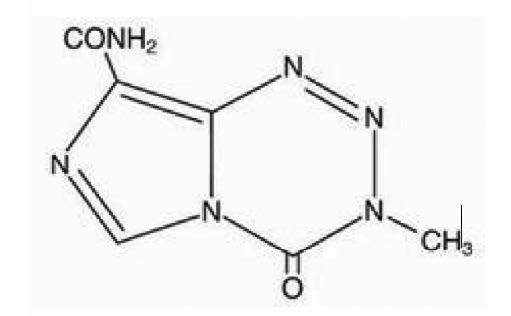
The material is a white to light tan/light pink powder with a molecular formula of C 6H 6N 6O 2and a molecular weight of 194.15. The molecule is stable at acidic pH (<5) and labile at pH >7; hence temozolomide, USP can be administered orally. The prodrug, temozolomide, is rapidly hydrolyzed to the active 5-(3-methyltriazen-1-yl) imidazole-4-carboxamide (MTIC) at neutral and alkaline pH values, with hydrolysis taking place even faster at alkaline pH.
Temozolomide Capsules, USP:
Temozolomide capsules, USP for oral use contain either 100 mg, 140 mg, 180 mg, or 250 mg of temozolomide.
The inactive ingredients are as follows:
Temozolomide Capsules 100 mg: lactose anhydrous (61.20 mg), colloidal silicon dioxide (0.80 mg), sodium starch glycolate (9.00 mg), tartaric acid (3.60 mg), and stearic acid (5.40 mg).
Temozolomide Capsules 140 mg: lactose anhydrous (85.68 mg), colloidal silicon dioxide (1.12 mg), sodium starch glycolate (12.60 mg), tartaric acid (5.04 mg), and stearic acid (7.56 mg).
Temozolomide Capsules 180 mg: lactose anhydrous (110.16 mg), colloidal silicon dioxide (1.44 mg), sodium starch glycolate (16.20 mg), tartaric acid (6.48 mg), and stearic acid (9.72 mg).
Temozolomide Capsules 250 mg: lactose anhydrous (153.00 mg), colloidal silicon dioxide (2.00 mg), sodium starch glycolate (22.50 mg), tartaric acid (9.00 mg), and stearic acid (13.50 mg).
The body of the capsules is made of gelatin and is opaque white with the dosage strength imprinted on them. The cap is also made of gelatin, imprinted with “NSP”, and the colors vary based on the dosage strength. The capsule body and cap are imprinted with pharmaceutical branding ink, which contains shellac, dehydrated alcohol, isopropyl alcohol, butyl alcohol, propylene glycol, strong ammonia solution, black iron oxide, and purified water.
Temozolomide Capsules 100 mg: The purple cap contains FD&C Blue #2, gelatin, iron oxide red, and titanium dioxide.
Temozolomide Capsules 140 mg: The blue cap contains FD&C Blue #2, gelatin, and titanium dioxide.
Temozolomide Capsules 180 mg: The orange cap contains gelatin, iron oxide red, iron oxide yellow, and titanium dioxide.
Temozolomide Capsules 250 mg: The white cap contains gelatin and titanium dioxide.
12 CLINICAL PHARMACOLOGY
12.1 Mechanism of Action
Temozolomide is not directly active but undergoes rapid nonenzymatic conversion at physiologic pH to the reactive compound 5-(3-methyltriazen-1-yl)-imidazole-4-carboxamide (MTIC). The cytotoxicity of MTIC is thought to be primarily due to DNA alkylation, mainly at the O 6 and N 7 positions of guanine, which causes DNA double strand breaks and results in programmed cell death.
12.2 Pharmacodynamics
Temozolomide exposure-response relationships and the time course of pharmacodynamic response are unknown.
12.3 Pharmacokinetics
Following a single oral dose of 150 mg/m 2, the mean C maxvalue is 7.5 mcg/mL for temozolomide and 282 ng/mL for MTIC. The mean AUC is 23.4 mcg·hr/mL for temozolomide and 864 ng·hr/mL for MTIC.
Following a single 90-minute intravenous infusion of 150 mg/m 2, the mean C maxis 7.3 mcg/mL and 276 ng/mL for MTIC. The mean AUC is 24.6 mcg·hr/mL for temozolomide and 891 ng·hr/mL for MTIC.
Temozolomide exhibits linear kinetics over the therapeutic dosing range of 75 mg/m 2/day to 250 mg/m 2/day.
Absorption
The median T maxis 1 hour.
Effect of Food
The mean C maxand AUC decreased by 32% and 9%, respectively, and median T maxincreased by 2-fold (from 1-2.25 hours) when Temozolomide capsules were administered after a modified high-fat breakfast (587 calories comprised of 1 fried egg, 2 strips of bacon, 2 slices of toast, 2 pats of butter, and 8 oz whole milk).
Distribution
Temozolomide has a mean (CV%) apparent volume of distribution of 0.4 L/kg (13%). The mean percent bound of drug-related total radioactivity is 15%.
Elimination
Clearance of temozolomide is approximately 5.5 L/hr/m 2and the mean elimination half-life is 1.8 hours.
Metabolism
Temozolomide is spontaneously hydrolyzed at physiologic pH to the active species, MTIC and to temozolomide acid metabolite. MTIC is further hydrolyzed to 5-amino-imidazole-4-carboxamide (AIC), which is known to be an intermediate in purine and nucleic acid biosynthesis, and to methylhydrazine, which is believed to be the active alkylating species. Cytochrome P450 enzymes play a minor role in the metabolism of temozolomide and MTIC. Relative to the AUC of temozolomide, the exposure to MTIC and AIC is 2.4% and 23%, respectively.
Excretion
Approximately 38% of the administered temozolomide total radioactive dose is recovered over 7 days: 38% in urine and 0.8% in feces. The majority of the recovered radioactivity in urine is unchanged temozolomide (6%), AIC (12%), temozolomide acid metabolite (2.3%), and unidentified polar metabolite(s) (17%).
Specific Populations
No clinically significant differences in the pharmacokinetics of temozolomide were observed based on age (range: 19-78 years), gender, smoking status (smoker vs. non-smoker), creatinine clearance (CLcr) of 36 to 130 mL/min/m 2, or mild to moderate hepatic impairment (Child Pugh class A and B). The pharmacokinetics of temozolomide has not been studied in patients with CLcr < 36 mL/min/m 2, end-stage renal disease on dialysis, or severe hepatic impairment (Child-Pugh class C).
Drug Interaction Studies
Clinical Studies and Model-Informed Approaches
No clinically significant differences in the pharmacokinetics of temozolomide or MTIC were observed when co-administered with ranitidine.
No clinically significant differences in the clearance of temozolomide or MTIC were predicted when co-administered with the following drugs: valproic acid, dexamethasone, prochlorperazine, phenytoin, carbamazepine, ondansetron, histamine-2-receptor antagonists, or phenobarbital.
13 NONCLINICAL TOXICOLOGY
13.1 Carcinogenesis, Mutagenesis, Impairment of Fertility
Temozolomide is carcinogenic in rats at doses less than the maximum recommended human dose. Temozolomide induced mammary carcinomas in both males and females at doses 0.13 to 0.63 times the maximum human dose (25 - 125 mg/m 2) when administered orally on 5 consecutive days every 28 days for 6 cycles. Temozolomide also induced fibrosarcomas of the heart, eye, seminal vesicles, salivary glands, abdominal cavity, uterus, and prostate, carcinomas of the seminal vesicles, schwannomas of the heart, optic nerve, and harderian gland, and adenomas of the skin, lung, pituitary, and thyroid at doses 0.5 times the maximum daily dose.
Mammary tumors were also induced following 3 cycles of temozolomide at the maximum recommended daily dose.
Temozolomide is a mutagen and a clastogen. In a reverse bacterial mutagenesis assay (Ames assay), temozolomide increased revertant frequency in the absence and presence of metabolic activation. Temozolomide was clastogenic in human lymphocytes in the presence and absence of metabolic activation.
Temozolomide impairs male fertility. Temozolomide caused syncytial cells/immature sperm formation at doses of 50 and 125 mg/m 2 (0.25 and 0.63 times the human dose of 200 mg/m 2) in rats and dogs, respectively, and testicular atrophy in dogs at 125 mg/m 2.
13.2 Animal Toxicology and/or Pharmacology
Toxicology studies in rats and dogs identified a low incidence of hemorrhage, degeneration, and necrosis of the retina at temozolomide doses equal to or greater than 125 mg/m 2 (0.63 times the human dose of 200 mg/m 2). These changes were most commonly seen at doses where mortality was observed.
14 CLINICAL STUDIES
14.1 Newly Diagnosed Glioblastoma
The efficacy of Temozolomide was evaluated in study MK-7365-051 ( NCT00006353), a randomized (1:1), multicenter, open-label trial. Eligible patients were required to have newly diagnosed glioblastoma. Patients were randomized to receive either radiation therapy alone or concomitant Temozolomide 75 mg/m 2 once daily starting the first day of radiation therapy and continuing until the last day of radiation therapy for 42 days (with a maximum of 49 days), followed by Temozolomide 150 mg/m 2 or 200 mg/m 2 once daily on Days 1 to 5 of each 28-day cycle, starting 4 weeks after the end of radiation therapy and continuing for 6 cycles. In both arms, focal radiation therapy was delivered as 60 Gy/30 fractions and included radiation to the tumor bed or resection site with a 2- to 3-cm margin. PCP prophylaxis was required during the concomitant phase regardless of lymphocyte count and continued until recovery of lymphocyte count to Grade 1 or less. The major efficacy outcome measure was overall survival.
A total of 573 patients were randomized, 287 to Temozolomide and radiation therapy and 286 to radiation therapy alone. At the time of disease progression, Temozolomide was administered as salvage therapy in 161 patients of the 282 (57%) in the radiation therapy alone arm and 62 patients of the 277 (22%) in the Temozolomide and radiation therapy arm.
The addition of concomitant and maintenance Temozolomide to radiation therapy for the treatment of patients with newly diagnosed glioblastoma showed a statistically significant improvement in overall survival compared to radiotherapy alone ( Figure 1). The hazard ratio (HR) for overall survival was 0.63 (95% CI: 0.52, 0.75) with a log-rank P<0.0001 in favor of the Temozolomide arm. The median overall survival was 14.6 months in the Temozolomide arm and 12.1 months for radiation therapy alone arm.
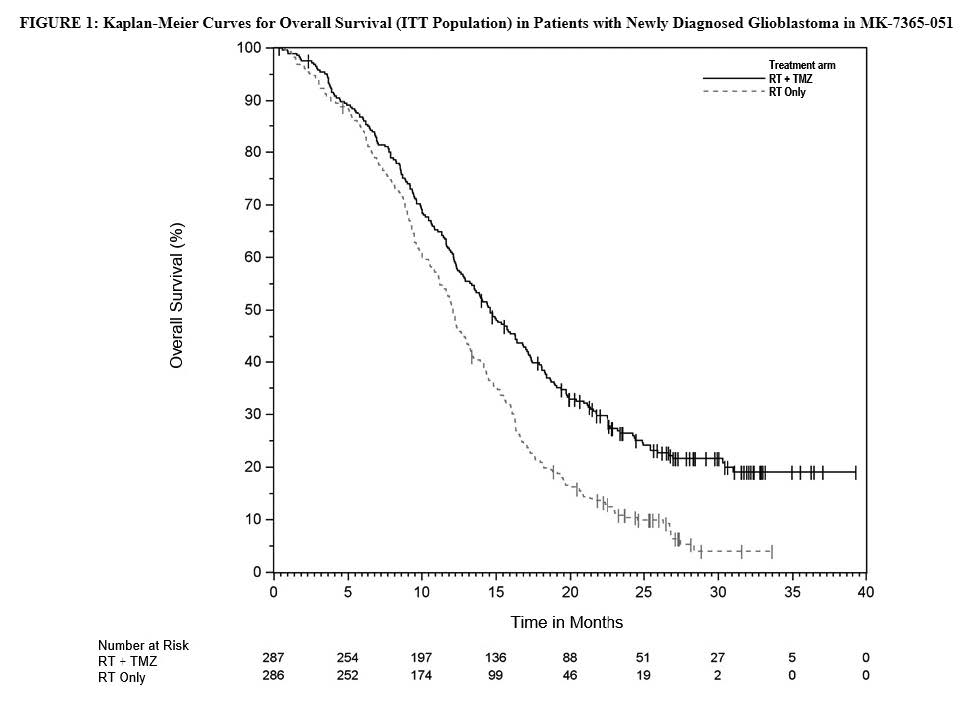
14.2 Anaplastic Astrocytoma
Newly Diagnosed Anaplastic Astrocytoma
The efficacy of TEMOZOLOMIDE for the adjuvant treatment of newly diagnosed anaplastic astrocytoma was derived from studies of TEMOZOLOMIDE in the published literature. TEMOZOLOMIDE was evaluated in CATNON ( NCT00626990), a randomized, open-label, multicenter trial, where the major efficacy outcome measure was overall survival.
Refractory Anaplastic Astrocytoma
The efficacy of Temozolomide was evaluated in Study MK-7365-006, a single-arm, multicenter trial. Eligible patients had anaplastic astrocytoma at first relapse and a baseline Karnofsky performance status (KPS) of 70 or greater. Patients had previously received radiation therapy and may also have previously received a nitrosourea with or without other chemotherapy. Fifty-four patients had disease progression on prior therapy with both a nitrosourea and procarbazine and their malignancy was considered refractory to chemotherapy (refractory anaplastic astrocytoma population). Temozolomide capsules were given on Days 1 to 5 of each 28-day cycle at a starting dose of 150 mg/m 2/day. If ANC was ≥1.5 x 10 9/L and platelet count was ≥100 x 10 9/L at the nadir and on Day 1 of the next cycle, the Temozolomide dose was increased to 200 mg/m 2/day. The major efficacy outcome measure was progression-free survival at 6 months and the additional efficacy outcome measures were overall survival and overall response rate.
In the refractory anaplastic astrocytoma population (n=54), the median age was 42 years (range:19 to 76); 65% were male; and 72% had a KPS of >80. Sixty-three percent of patients had surgery other than a biopsy at the time of initial diagnosis. Of those patients undergoing resection, 73% underwent a subtotal resection and 27% underwent a gross total resection. Eighteen percent of patients had surgery at the time of first relapse. The median time from initial diagnosis to first relapse was 13.8 months (range: 4.2 months to 6.3 years).
In the refractory anaplastic astrocytoma population, the overall response rate (CR+PR) was 22% (12 of 54 patients) and the complete response rate was 9% (5 of 54 patients). The median duration of all responses was 50 weeks (range: 16 to 114 weeks) and the median duration of complete responses was 64 weeks (range: 52 to 114 weeks). In this population, progression-free survival at 6 months was 45% (95% CI: 31%, 58%) and progression-free survival at 12 months was 29% (95% CI: 16%, 42%). Median progression-free survival was 4.4 months. Overall survival at 6 months was 74% (95% CI: 62%, 86%) and 12-month overall survival was 65% (95% CI: 52%, 78%). Median overall survival was 15.9 months.
16 HOW SUPPLIED / STORAGE AND HANDLING
Temozolomide is a hazardous drug. Follow applicable special handling and disposal procedures. 1
Temozolomide Capsules, USP
Temozolomide Capsules, USP are supplied in sachets containing the following capsule strengths:
Temozolomide Capsules 100 mg: have opaque white bodies with opaque purple caps. The cap is imprinted with “NSP” and the capsule body is imprinted with “100mg” in black ink.
They are supplied as follows:
14-count - NDC: 58181-4321-4
Temozolomide Capsules 140 mg: have opaque white bodies with opaque blue caps. The cap is imprinted with “NSP” and the capsule body is imprinted with “140mg” in black ink.
They are supplied as follows:
14-count - NDC: 58181-4331-4
Temozolomide Capsules 180 mg: have opaque white bodies with opaque orange caps. The cap is imprinted with “NSP” and the capsule body is imprinted with “180mg” in black ink.
They are supplied as follows:
14-count - NDC: 58181-4341-4
Temozolomide Capsules 250 mg: have opaque white bodies with opaque white caps. The cap is imprinted with “NSP” and the capsule body is imprinted with “250mg” in black ink.
They are supplied as follows:
5-count - NDC: 58181-4351-4
Store Temozolomide Capsules at 25°C (77°F); excursions permitted to 15°-30°C (59°-86°F) [see USP Controlled Room Temperature].
17 PATIENT COUNSELING INFORMATION
Advise the patient to read the FDA-approved patient labeling (Patient Information).
Myelosuppression
Inform patients that Temozolomide can cause low blood cell counts and the need for frequent monitoring of blood cell counts. Advise patients to contact their healthcare provider immediately for bleeding, fever, or other signs of infection [see Warnings and Precautions ( 5.1)] .
Hepatotoxicity
Advise patients of the increased risk of hepatotoxicity and to contact their healthcare provider immediately for signs or symptoms of hepatotoxicity. Inform patients that they will have periodic liver enzyme tests during treatment and following the last dose of Temozolomide [see Warnings and Precautions ( 5.2)] .
Pneumocystis Pneumonia
Advise patients of the increased risk of Pneumocystis pneumonia and to contact their healthcare provider immediately for new or worsening pulmonary symptoms. Inform patients that prophylaxis for Pneumocystispneumonia may be needed [see Dosage and Administration ( 2.1), Warnings and Precautions ( 5.3)] .
Secondary Malignancies
Advise patients of the increased risk of myelodysplastic syndrome and secondary malignancies [see Warnings and Precautions ( 5.4)] .
Exposure to Opened Capsules
Advise patient to not open, chew, or dissolve the capsules. If capsules are accidentally opened or damaged, advise patients to take rigorous precautions with capsule contents to avoid inhalation or contact with the skin or mucous membranes [see Warnings and Precautions ( 5.6)] . In case of powder contact, wash the affected area with water immediately [see Dosage and Administration ( 2.4)] .
Embryo-Fetal Toxicity
Advise pregnant women and females of reproductive potential of the potential risk to a fetus. Advise females to inform their healthcare provider of a known or suspected pregnancy
[see Warnings and Precautions (
5.5), Use in Specific Populations (
8.1)]
.
Advise females of reproductive potential to use effective contraception during treatment with Temozolomide and for 6 months after the last dose
[see Use in Specific Populations (
8.3)]
.
Advise male patients with pregnant partners or female partners of reproductive potential to use condoms during treatment with Temozolomide and for 3 months after the last dose
[see Use in Specific Populations (
8.3), Nonclinical Toxicology (
13.1)]
.
Advise male patients not to donate semen during treatment with Temozolomide and for 3 months after the last dose
[see Use in Specific Populations (
8.3), Nonclinical Toxicology (
13.1)]
.
Lactation
Advise women not to breastfeed during treatment with Temozolomide and for 1 week after the last dose [see Use in Specific Populations ( 8.2)] .
Infertility
Advise males of reproductive potential that Temozolomide may impair fertility [see Use in Specific Populations ( 8.3), Nonclinical Toxicology ( 13.1)] .
Manufactured by:
Eirgen Pharma Ltd.
Waterford, Ireland
Distributed by:
NextSource Pharma,
Pompano Beach, FL 33069, USA
Made in Ireland
PC2596
Rev. 08/2024
Patient Information
|
Temozolomide (tem" oh zol' oh mide) Capsules, USP |
|
| What is Temozolomide?
Temozolomide is a prescription medicine used to treat adults with certain brain cancer tumors. It is not known if Temozolomide is safe and effective in children. |
|
|
Do not take TEMOZOLOMIDE if you:
|
|
|
Before taking or receiving TEMOZOLOMIDE, tell your healthcare provider about all of your medical conditions, including if you:
Tell your doctor about all the medicines you take, including prescription and non-prescription medicines, vitamins, and herbal supplements. Know the medicines you take. Keep a list of them and show it to your healthcare provider and pharmacist when you get a new medicine. |
|
|
How should I take TEMOZOLOMIDE?
TEMOZOLOMIDE capsules:
|
|
|
What are the possible side effects of TEMOZOLOMIDE? TEMOZOLOMIDE can cause serious side effects, including:
Common side effects of TEMOZOLOMIDE include:
TEMOZOLOMIDE can affect fertility in males and may affect your ability to father a child. Talk with your healthcare provider if fertility is a concern for you. Tell your healthcare provider about any side effect that bothers you or that does not go away. These are not all the possible side effects of TEMOZOLOMIDE. For more information, ask your healthcare provider or pharmacist. Call your doctor for medical advice about side effects. You may report side effects to FDA at 1-800-FDA-1088. |
|
|
How should I store TEMOZOLOMIDE capsules?
Keep TEMOZOLOMIDE and all medicines out of the reach of children. |
|
| General information about the safe and effective use of TEMOZOLOMIDE.
Medicines are sometimes prescribed for purposes other than those listed in a Patient Information leaflet. Do not use TEMOZOLOMIDE for a condition for which it was not prescribed. Do not give TEMOZOLOMIDE to other people, even if they have the same symptoms that you have. It may harm them. You can ask your pharmacist or healthcare provider for information about TEMOZOLOMIDE that is written for health professionals. |
|
|
What are the ingredients in TEMOZOLOMIDE?
TEMOZOLOMIDE capsules:
Inactive ingredients:lactose anhydrous, colloidal silicon dioxide, sodium starch glycolate, tartaric acid, stearic acid. The body of the capsules is made of gelatin and is opaque white. The cap is also made of gelatin, and the colors vary based on the dosage strength. The capsule body and cap are imprinted with pharmaceutical branding ink, which contains shellac, dehydrated alcohol, isopropyl alcohol, butyl alcohol, propylene glycol, purified water, strong ammonia, and ferric oxide. TEMOZOLOMIDE 100 mg: The purple cap contains gelatin, titanium dioxide, and iron oxide red, and FD&C Blue #2.
|
|
|
This Patient Information has been approved by the U.S. Food and Drug Administration |
Revised: 08/2024 |
Principal Display Panel - Carton - NDC: 58181-4321-4 - 100 mg Capsules - 14 Individual Sachets
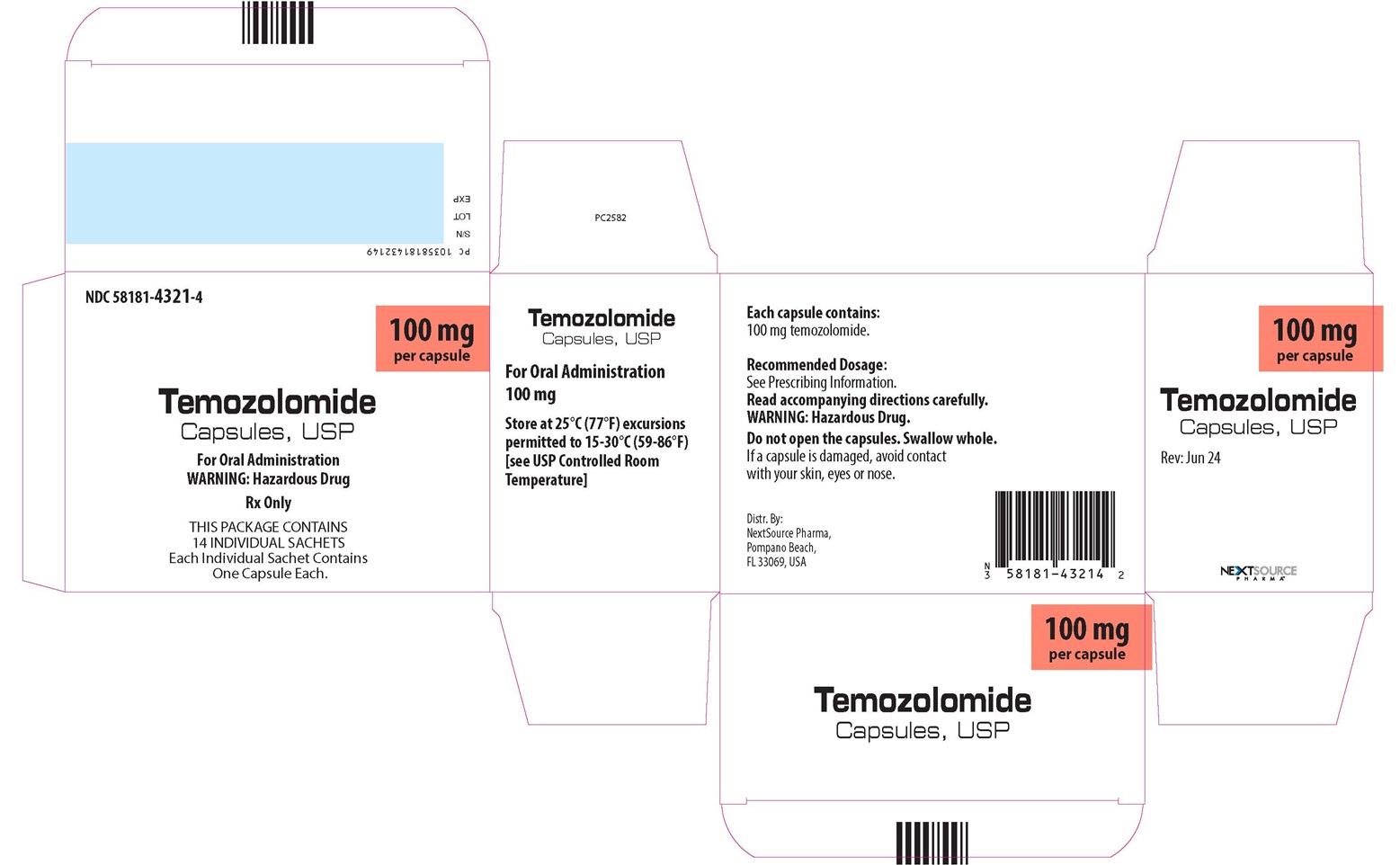
NDC: 58181-4321-4
100 mg per capsule
Temozolomide
Capsules, USP
For Oral Administration
WARNING: Hazardous Drug
Rx Only
THIS PACKAGE CONTAINS
14 INDIVIDUAL SACHETS
Each Individual Sachet Contains One Capsule Each.
Temozolomide
Capsules, USP
For Oral Administration
100 mg
Store at 25ºC (77ºF) excursions permitted to 15-30ºC (59-86ºF) [see USP Controlled Room Temperature]
Each Capsule Contains:
100 mg temozolomide.
Recommended Dosage:
See Prescribing Information.
Read accompanying directions carefully.
WARNING: Hazardous Drug.
Do not open the capsules. Swallow whole.
If a capsule is damaged, avoid contact with your skin, eyes or nose.
Distr. By:
NextSource Pharma,
Pompano Beach,
FL 33069, USA
N3 58181-43214 2
100 mg per capsule
Temozolomide
Capsules, USP
Rev: Jun 24
NextSource Pharma
PC 10358181432149
S/N
LOT
EXP
PC2582
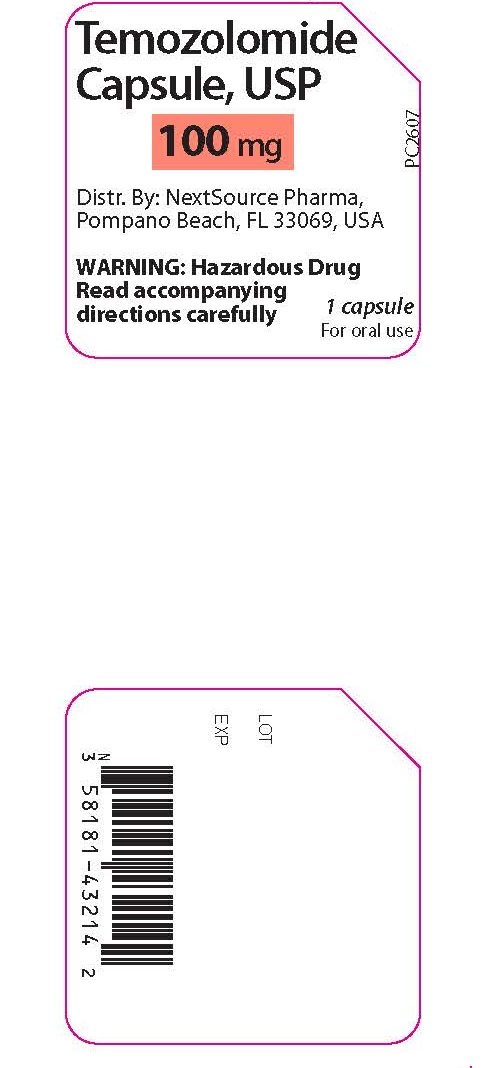
Temozolomide Capsules, USP
100 mg
PC2607
Distr. By: NextSource Pharma,
Pompano Beach, FL 33069, USA
WARNING: Hazardous Drug
Read accompanying directions carefully
1 capsule
For oral use
LOT
EXP
N3 58181-43214 2
Principal Display Panel - Carton - NDC: 58181-4331-4 - 140 mg Capsules - 14 Individual Sachets
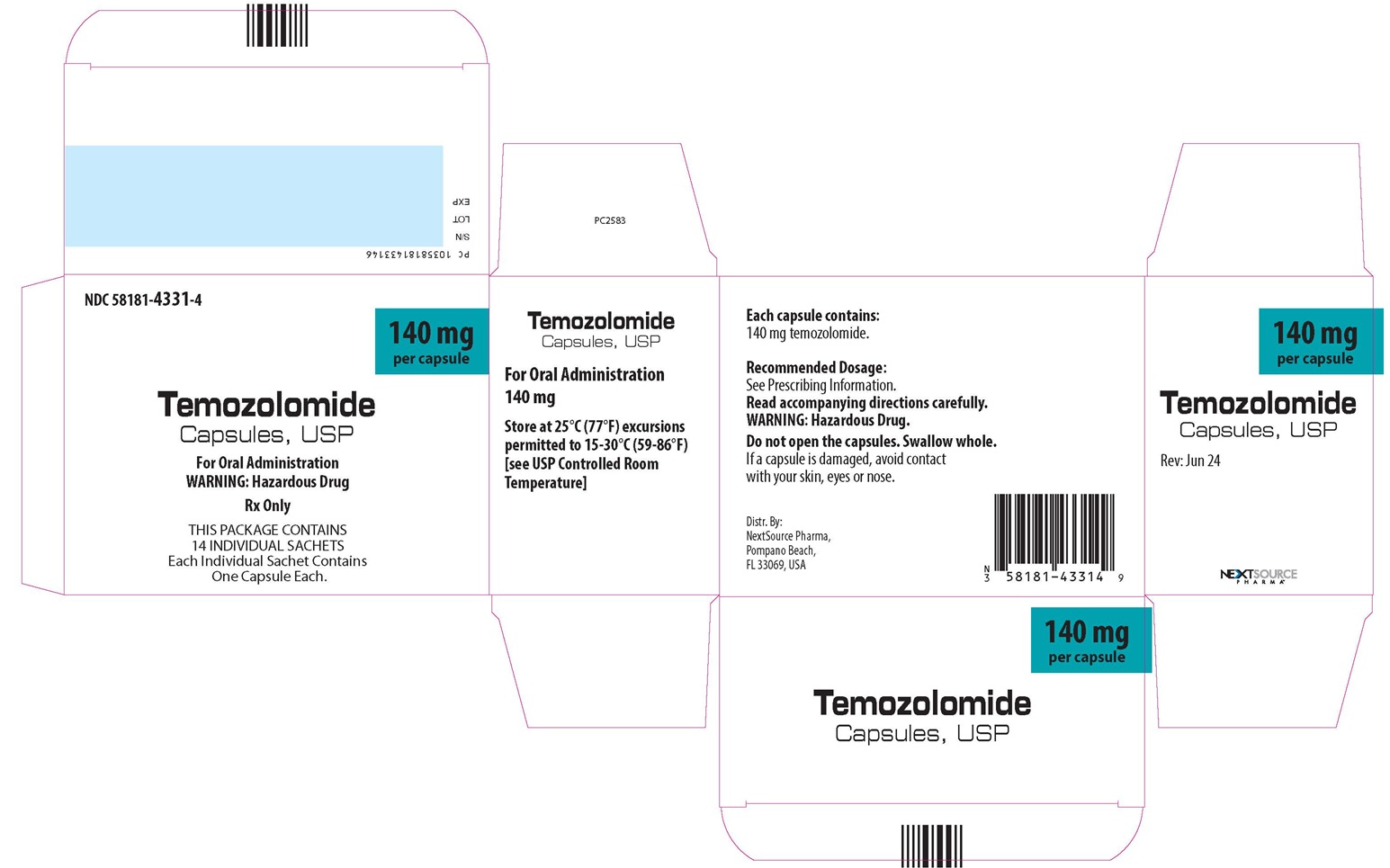
NDC: 58181-4331-4
140 mg per capsule
Temozolomide
Capsules, USP
For Oral Administration
WARNING: Hazardous Drug
Rx Only
THIS PACKAGE CONTAINS
14 INDIVIDUAL SACHETS
Each Individual Sachet Contains One Capsule Each.
Temozolomide
Capsules, USP
For Oral Administration
140 mg
Store at 25ºC (77ºF) excursions permitted to 15-30ºC (59-86ºF) [see USP Controlled Room Temperature]
Each Capsule Contains:
140 mg temozolomide.
Recommended Dosage:
See Prescribing Information.
Read accompanying directions carefully.
WARNING: Hazardous Drug.
Do not open the capsules. Swallow whole.
If a capsule is damaged, avoid contact with your skin, eyes or nose.
Distr. By:
NextSource Pharma,
Pompano Beach,
FL 33069, USA
N3 58181-43314 9
140 mg per capsule
Temozolomide
Capsules, USP
Rev: Jun 24
NextSource Pharma
PC 10358181433146
S/N
LOT
EXP
PC2583
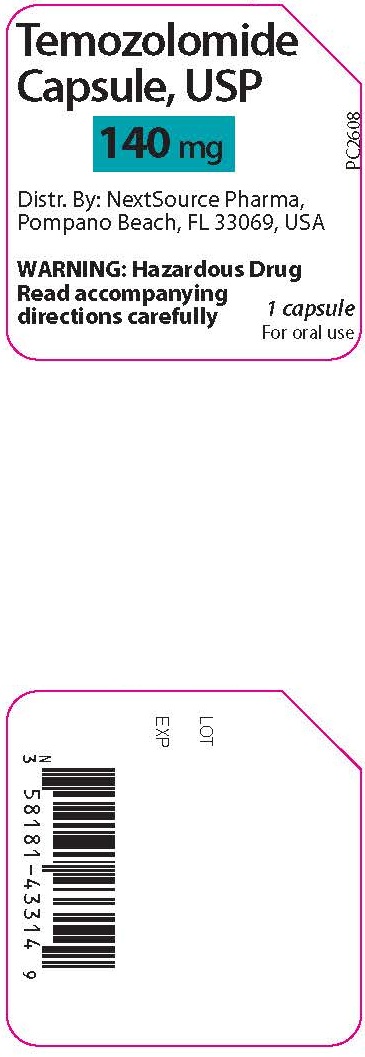
Temozolomide Capsules, USP
140 mg
Distr. by: NextSource Pharma,
Pompano Beach, FL 33069, USA
WARNING: Hazardous Drug
Read accompanying directions carefully
PC2608
1 capsule
For oral use
LOT
EXP
N3 58181-43314 9
Principal Display Panel - Carton - NDC: 58181-4341-4 - 180 mg Capsules - 14 Individual Sachets
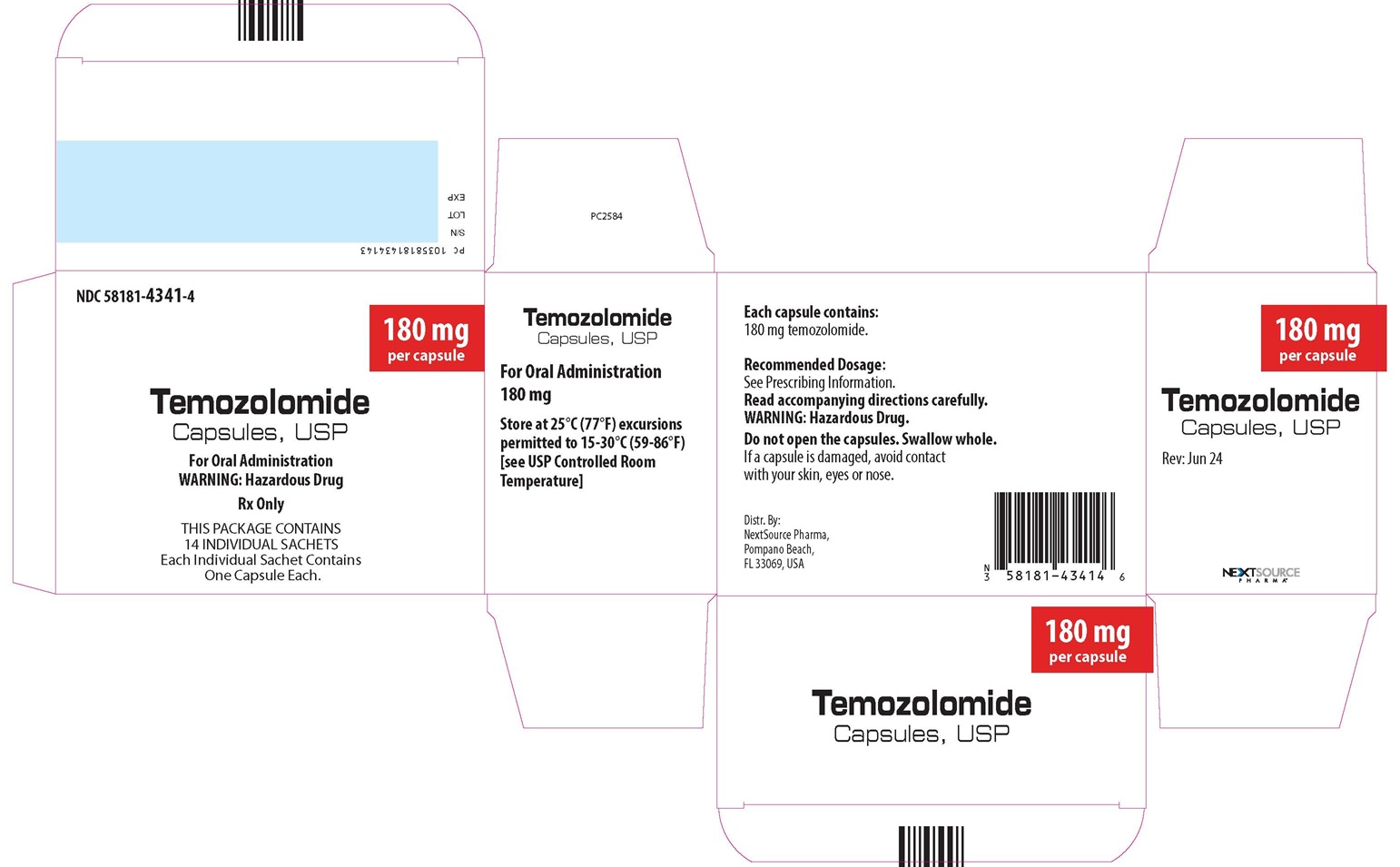
NDC: 58181-4341-4
180 mg per capsule
Temozolomide
Capsules, USP
For Oral Administration
WARNING: Hazardous Drug
Rx Only
THIS PACKAGE CONTAINS
14 INDIVIDUAL SACHETS
Each Individual Sachet Contains One Capsule Each.
Temozolomide
Capsules, USP
For Oral Administration
180 mg
Store at 25ºC (77ºF) excursions permitted to 15-30ºC (59-86ºF) [see USP Controlled Room Temperature]
Each Capsule Contains:
180 mg temozolomide.
Recommended Dosage:
See Prescribing Information.
Read accompanying directions carefully.
WARNING: Hazardous Drug.
Do not open the capsules. Swallow whole.
If a capsule is damaged, avoid contact with your skin, eyes or nose.
Distr. By:
NextSource Pharma,
Pompano Beach,
FL 33069, USA
N3 58181-43414 6
180 mg per capsule
Temozolomide
Capsules, USP
Rev: Jun 24
NextSource Pharma
PC 10358181434143
S/N
LOT
EXP
PC2584
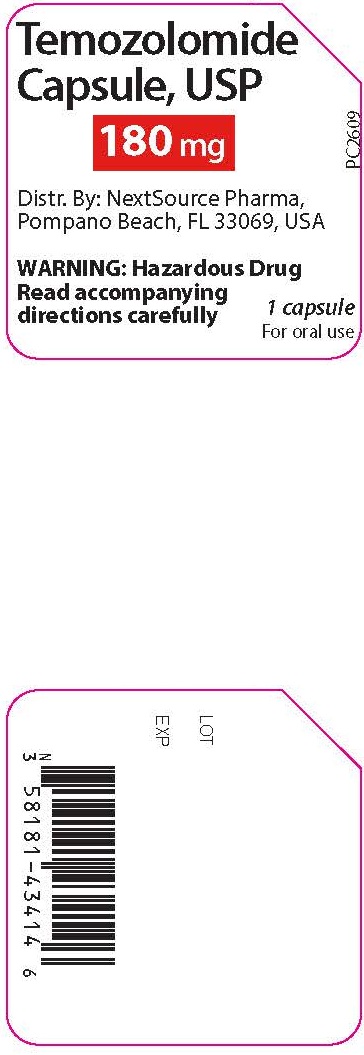
Temozolomide Capsules, USP
180 mg
Distr. By: NextSource Pharma,
Pompano Beach, FL 33069, USA
PC2609
WARNING: Hazardous Drug
Read accompanying directions carefully
1 capsule
For oral use
LOT
EXP
N3 58181-43414 6
Principal Display Panel - Carton - NDC: 58181-4351-4 - 250 mg Capsules - 5 Individual Sachets
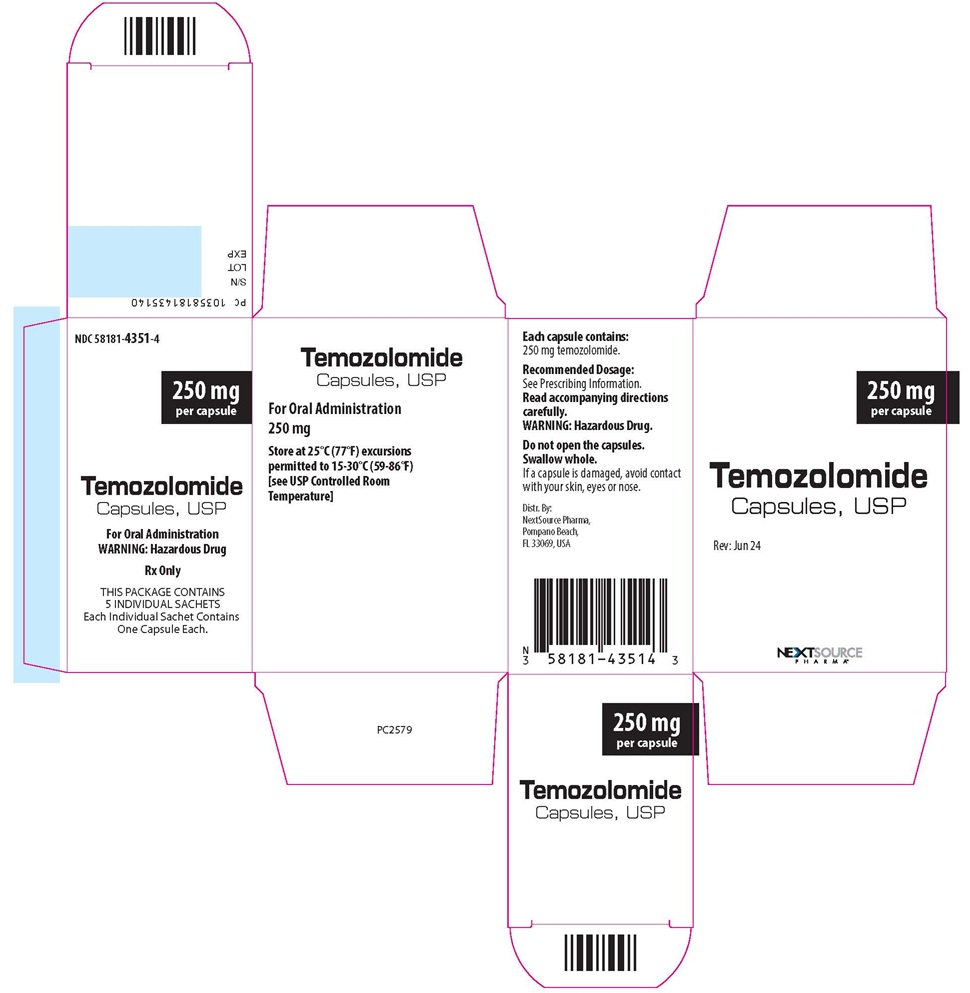
NDC: 58181-4351-4
250 mg per capsule
Temozolomide
Capsules, USP
For Oral Administration
WARNING: Hazardous Drug
Rx Only
THIS PACKAGE CONTAINS
5 INDIVIDUAL SACHETS
Each Individual Sachet Contains One Capsule Each.
Temozolomide
Capsules, USP
For Oral Administration
250 mg
Store at 25ºC (77ºF) excursions permitted to 15-30ºC (59-86ºF) [see USP Controlled Room Temperature]
Each Capsule Contains:
250 mg temozolomide.
Recommended Dosage:
See Prescribing Information.
Read accompanying directions carefully.
WARNING: Hazardous Drug.
Do not open the capsules. Swallow whole.
If a capsule is damaged, avoid contact with your skin, eyes or nose.
Distr. By:
NextSource Pharma,
Pompano Beach,
FL 33069, USA
N3 58181-43514 3
250 mg per capsule
Temozolomide
Capsules, USP
Rev: Jun 24
NextSource Pharma
PC 10358181435140
S/N
LOT
EXP
PC2579
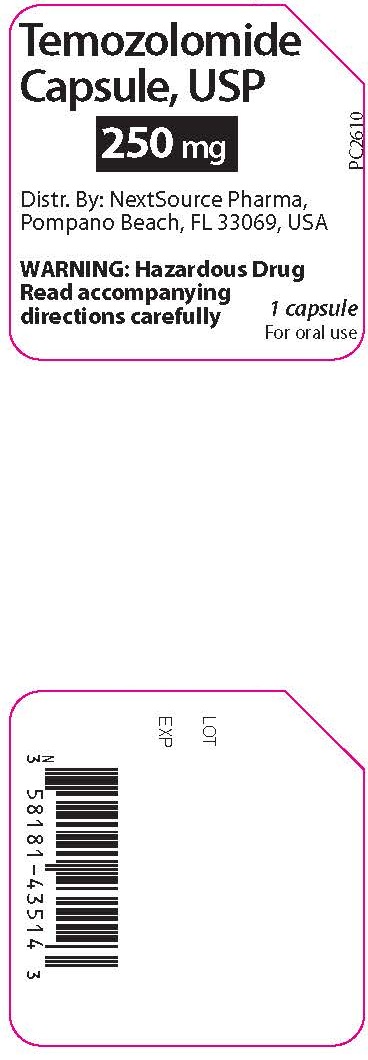
Temozolomide Capsules, USP
250 mg
Distr. By: NextSource Pharma,
Pompano Beach, FL 33069, USA
PC2610
WARNING: Hazardous Drug
Read accompanying directions carefully
1 capsule
For oral use
LOT
EXP
N3 58181-43514 3
| TEMOZOLOMIDE
temozolomide capsule |
||||||||||||||||||||||||||||||||||||
|
||||||||||||||||||||||||||||||||||||
|
||||||||||||||||||||||||||||||||||||
|
||||||||||||||||||||||||||||||||||||
|
||||||||||||||||||||||||||||||||||||
|
||||||||||||||||||||||||||||||||||||
|
||||||||||||||||||||||||||||||||||||
| TEMOZOLOMIDE
temozolomide capsule |
||||||||||||||||||||||||||||||||||||||
|
||||||||||||||||||||||||||||||||||||||
|
||||||||||||||||||||||||||||||||||||||
|
||||||||||||||||||||||||||||||||||||||
|
||||||||||||||||||||||||||||||||||||||
|
||||||||||||||||||||||||||||||||||||||
|
||||||||||||||||||||||||||||||||||||||
| TEMOZOLOMIDE
temozolomide capsule |
||||||||||||||||||||||||||||||||||||||
|
||||||||||||||||||||||||||||||||||||||
|
||||||||||||||||||||||||||||||||||||||
|
||||||||||||||||||||||||||||||||||||||
|
||||||||||||||||||||||||||||||||||||||
|
||||||||||||||||||||||||||||||||||||||
|
||||||||||||||||||||||||||||||||||||||
| TEMOZOLOMIDE
temozolomide capsule |
||||||||||||||||||||||||||||||||||
|
||||||||||||||||||||||||||||||||||
|
||||||||||||||||||||||||||||||||||
|
||||||||||||||||||||||||||||||||||
|
||||||||||||||||||||||||||||||||||
|
||||||||||||||||||||||||||||||||||
|
||||||||||||||||||||||||||||||||||
| Labeler - NextSource Biotechnology LLC (078779322) |
| Establishment | |||
| Name | Address | ID/FEI | Business Operations |
|---|---|---|---|
| Eirgen Pharma Ltd. | 989968644 | manufacture(58181-4321, 58181-4331, 58181-4341, 58181-4351) | |